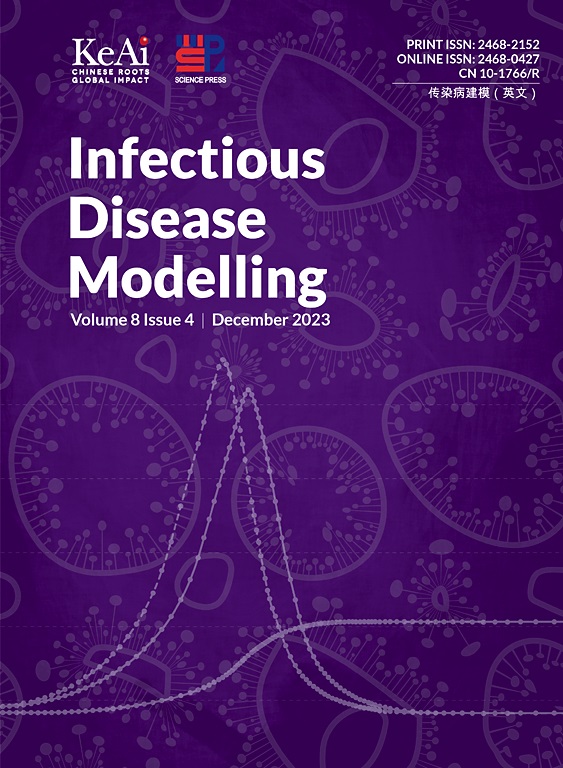Modeling Neisseria meningitidis transmission dynamics and the impact of pentavalent vaccination targeting serogroups A, C, W-135, Y, and X in the African meningitis belt
IF 2.5
3区 医学
Q1 Medicine
引用次数: 0
Abstract
The African meningitis belt (AMB) faces recurring epidemics of Neisseria meningitidis (Nm) (a bacterium that causes meningococcal meningitis), posing significant public health challenges. This study develops a Susceptible-Carrier-Infected-Recovered (SCIR)-based dynamic model to investigate Nm transmission dynamics in the AMB region, focussing on the impact of pentavalent meningococcal conjugate vaccines targeting serogroups A, C, W-135, Y, and X. By incoporating vaccination strategies into the model, we provide a comprehensive framework for evaluating vaccine effectiveness and informing outbreak prevention and control efforts. Our model stratifies the population into high-risk individuals (ages 1–29 years), who are the primary targets of vaccination campaigns, and low-risk individuals (all other age groups), capturing differences in susceptibility and vaccine coverage. Our results reveal that the introduction of pentavalent vaccines significantly reduces the prevalence of carriers, particularly among high-risk groups, thereby curbing transmission and mitigating epidemic risks across the AMB region. Key epidemiological parameters, including reproduction numbers (R0), are derived to support targeted intervention strategies. Further analysis highlights the role of vaccination in lowering Nm transmissibility, especially in densely populated settings where close contact accelerates spread. Moreover, potential drivers of Nm outbreaks, including climate variability, socioeconomic disparities, and population density, are identified, highlighting the need for integrated public health intervention strategies. Further simulations also reveal the effectiveness of pentavalent vaccination among high-risk populations; however, further research is urgently needed to understand disease heterogeneity and vulnerability, particularly in young children and underserved communities. Thus, this study contribute to advancing our understanding of effective and sustainable vaccination strategies and enhancing epidemic preparedness in meningitis-endemic regions.
模拟脑膜炎奈瑟菌在非洲脑膜炎带的传播动态和针对血清群A、C、W-135、Y和X的五价疫苗接种的影响
非洲脑膜炎带(AMB)面临脑膜炎奈瑟菌(Nm)(一种引起脑膜炎球菌性脑膜炎的细菌)的反复流行,构成重大的公共卫生挑战。本研究建立了一个基于易感-携带者-感染-恢复(SCIR)的动态模型来研究AMB地区的Nm传播动力学,重点关注针对血清群a、C、W-135、Y和x的五价脑膜炎球菌结合疫苗的影响。通过将疫苗接种策略纳入模型,我们为评估疫苗有效性和为疫情防控工作提供了一个全面的框架。我们的模型将人群分为高危人群(1-29岁),他们是疫苗接种运动的主要目标,以及低风险人群(所有其他年龄组),捕捉易感性和疫苗覆盖率的差异。我们的研究结果表明,五价疫苗的引入显著降低了携带者的患病率,特别是在高危人群中,从而抑制了传播并降低了AMB地区的流行病风险。包括繁殖数(R0)在内的关键流行病学参数被导出,以支持有针对性的干预策略。进一步分析强调了疫苗接种在降低新冠病毒传播率方面的作用,特别是在密切接触加速传播的人口稠密环境中。此外,还确定了Nm暴发的潜在驱动因素,包括气候变异、社会经济差异和人口密度,强调了综合公共卫生干预战略的必要性。进一步的模拟还揭示了五价疫苗在高危人群中的有效性;然而,迫切需要进一步的研究来了解疾病的异质性和脆弱性,特别是在幼儿和服务不足的社区。因此,这项研究有助于增进我们对有效和可持续的疫苗接种战略的理解,并加强脑膜炎流行地区的流行病防范。
本文章由计算机程序翻译,如有差异,请以英文原文为准。
求助全文
约1分钟内获得全文
求助全文
来源期刊

Infectious Disease Modelling
Mathematics-Applied Mathematics
CiteScore
17.00
自引率
3.40%
发文量
73
审稿时长
17 weeks
期刊介绍:
Infectious Disease Modelling is an open access journal that undergoes peer-review. Its main objective is to facilitate research that combines mathematical modelling, retrieval and analysis of infection disease data, and public health decision support. The journal actively encourages original research that improves this interface, as well as review articles that highlight innovative methodologies relevant to data collection, informatics, and policy making in the field of public health.
 求助内容:
求助内容: 应助结果提醒方式:
应助结果提醒方式:


